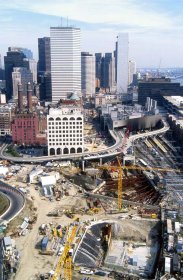
 |
| The
Central Artery/Tunnel Project includes the largest application of
of
slurry trench diaphragm walls anywhere in North America.
What is a slurry trench diaphragm wall? The slurry trench diaphragm wall is the single most important construction technique on this gigantic project, and it's the primary tool the designers are using to help the project keep its most important promise to the people of Boston: Keeping the city open and operating for business and traffic moving during more than a decade of construction. A slurry wall is a concrete wall that runs from the surface of the ground down to or into bedrock. It defines the area to be excavated for the underground highway and eventually forms the actual walls of the new Central Artery. "Slurry" refers to a bentonite (clay)-water mixture that is pumped into the excavation for the wall to keep the sides laterally supported intact until concrete is placed. Properly applied, the bentonite that penetrates the gound may serve to retard moisture from enterning an excavation made on one side of the wall. Here is how a slurry wall is constructed: First, a trench about three feet thick by ten feet wide is dug by a special type of excavating machine down to bedrock, which on the Central Artery project is more than 120 feet in depth in some locations. As the ground is removed (either by a clamshell excavator by a continuous milling machine that grinds away obstructions with rotating wheels) the liquid slurry is pumped into the hole. The slurry, a mixture of Bentonite Clay and water mixture, is just heavy enough to keep the walls of these very deep excavations intact before large reinforcing steel cages are lowered into the trenches and concrete is pumped in to fill the remainder of the excavated slot. As the concrete displaces the slurry, the slurry is pumped to storage for re-use. Each slurry wall "panel" takes about two days to dig, reinforce, and fill. The side-by-side panels form the walls of the underground Central Artery. A total of more than 26,000 linear feet of slurry walls – about five miles in total length – are part of the project, one ten-foot trench constructed at a time. Once the walls are in, large steel beams are placed between them at ground level and concrete decking placed on the beams. Traffic and construction equipment move on the decking as soil is excavated below and removed through "glory holes" where sections of decking have been removed. As excavation proceeds, struts (large steel members) are installed horizontally across the exavation between the walls to counter pressure from the ground and surcharge from nearby buildings. Once the excavation and the struts removed as the roadbed is built up. The remainder of the excavation is filled to the surface after the roadway is finished. Slurry trench diaphragm walls are essential to the success of the Central Artery project because the special excavating equipment can work in confined spaces in a dense old city such as Boston (the machinery was first developed in Europe), particularly under the elevated highway where there is no headroom for tall conventional excavators. The walls produce a rigid work area for excavating the tunnel without the need for a much wider conventional trench with sloping sides, which would be impossible in the narrow corridor where the elevated highway now stands. But perhaps
the most
crucial use of the walls involves the old
highway itself. The existing six-lane elevated highway must remain
in service
throughout construction
even as a wider, eight-to-ten lane expressway is built
directly underneath it. Placement of the decking
and excavation of the tunnel require that all of the footings that support beams holding up
the old road be removed, so the So the slurry trench diaphragm walls make construction of the new highway possible in the tight confines of old Boston, and they let the project keep its key commitment to the city, with surface traffic moving on the decking and the walls holding the crowded old highway aloft as construction proceeds below. |
Return to Front Page of Lawrence B. Karp Consulting Engineer